THE TRESTLE BOARD
by W.B. Harold Meij
Introduction
One of the main objectives of a Mason is to endeavor to improve
himself throughout the several stages of life. Freemasonry has devised three
degrees whereby its members can symbolically improve themselves, learning by
experience and from fellow members along the way. What makes Freemasonry so
special is the fact that like-minded people can share experiences, viewpoints
and knowledge from a common base. The several symbols, rituals and “teachings” of Freemasonry are designed to be an initial
push, or merely a seed to “jump-start” the mind
- what people take out of it depends on how much effort they add themselves.
Just like a seed, it cannot grow without light, water, warmth, soil, and many
other factors. Similarly, Masonry and minds cannot grow without participation of
those involved in it.
Yet all this must start somewhere, and Freemasonry has provided
ample material through symbols, items, rituals and the like to serve as such
seeds. One of the most important of these teaching tools that has been used
throughout the long years has been the trestleboard.
What is it? Where and how did it originate? Why are some
trestleboards different than others? Why have they changed through time?
As each degree has its own unique “teachings”, so are there different trestleboards
for each degree. As this is the first attempt to shed some more light on this
all-important item, and as any trestleboard is so rich in symbols, it will be
difficult to cover all subjects in one paper. Therefore, I have chosen to focus
on the first degree trestleboard.
Historical background
The trestleboard has been a central tool for Masonic teachings,
but the form of the trestleboard has changed throughout time. In ancient times
the need for secrecy was larger, as dis- and mis-information about Freemasonry
required its members to pay particular close attention to what, and how, Masonic “teachings” were given. For this reason, the
trestleboard, with the several objects and symbols, were drawn in sand from
memory. No written copies were available. In former times, it was the duty of
the Tyler to literally draw the trestleboard in the sand inside the Lodge, or
other meeting place, at the beginning of each meeting. In effect, not only was
the Tyler responsible for literally tyling the Lodge, but also, by drawing the
trestleboard, to enable the brethren to commence their work - something most of
us would today identify as being the responsibility of the Worshipful Master.
This historical background can still be seen in England, where
this practice was called “drawing the Lodge.” In France it was termed “plan de la Loge,” presumably because without the “plan” there could be no work. In France the trestleboard was termed “le tableau,” which is more likely in reference to
painting the board of later years, and in England it was often called a “tracing board,” for it was the Tyler that had to trace
the symbols from memory. Considerable time had to be spend by the Tyler to
memorize the correct symbols and placement for each degree, and there are
records that he was sometimes compensated with a small fee for his efforts.
During later periods, meetings often took place in taverns, and
chalk and charcoal were used to draw the trestleboard on the wooden floor. This
way, should the need arise, the trestleboard could immediately be erased without
a trace. Indeed, as taverns were public, it was standard practice to erase the
trestleboard at the end of all functions, and it was the duty of the youngest
member of the degree in which the meeting was held, to see to it that all traces
were erased. It is for this reason that mops and pails were often listed in a
Lodge’s standard inventory.
The tedious job of having to draw the trestleboard before every meeting with
chalk and charcoal later gave way in the 18th century to permanent wooden, or
cloth trestleboards being fixed to the floor through tape and nails. This was
probably because the need for secrecy lessened during this period, and many
lodges had obtained a more permanent location to meet than the local tavern. It
was also better for the tavern operator, or owner, for despite all the cleaning,
chalk and charcoal probably still left some nasty stains.
In former times, a lodge usually had only one wooden
trestleboard, showing the symbols for all three degrees in one board. These
permanent boards eventually were replaced by tracing boards, one for each
degree, which were generally smaller, more durable, and illustrated the same
points when taken together. With three trestleboards, all the important and
relevant symbols of each degree could be included in detail - as they are
generally done so today.
Placement of the trestleboard
As can be seen from the above historical background,
trestleboards were originally drawn on the floor of the meeting place. This is
still so in many European Lodges. In the USA, the trestleboard is a permanent
board, placed in the Lodge when the need for instruction arises, and thus the
term trestleboard is most likely derived from boards being placed on trestles.
In our lodge for example, we use only permanent trestleboards for degree work,
and the lodge carpet actually functions as the “ancient” tableau, showing only the most important of symbols - the blazing star,
indented trestle and checkered cubes. It is therefore interesting to note that
the indented trestle, and checkered cubes of our lodge are almost always found
on ancient trestleboards.
This is in contrast to many lodges in Europe, where the floor
is barren, and when lodge work commences, the trestleboard (which can be as big
as our carpet) is placed within the lodge. This is still common in many German
and Swedish lodges, whereby several brethren, following strict ceremony, carry
the large (usually folded) trestleboard into the lodge during the opening
ceremonies, and remove it at the closing of a lodge.
In European lodges, the trestleboard is placed in the center of
the Lodge, stretching from East to West.
The trestleboard is never to be treaded on, except by the WM
for instruction or by the candidate in the work of the third degree.
Some lodges actually “build” their trestleboard using life-size objects. For example, on the carpet
would be placed a real rough ashlar, a real perfect ashlar, a real light (for
the sun) and a covered one for the moon and so on.
Dimensions of a trestleboard
The traditional dimensions of a trestleboard are supposed to
follow the “golden
rule”, i.e. 1:1.62 (1+ √5
/ 2 - also known as Sectio Divina, Sectio Aurea, Divine proportion, Golden Mean,
Golden Phi etc.) The Golden mean is a natural number that is said to arise out
of the basic structure of the universe. A brief explanation of this number is
essential to understand why it should be incorporated in the dimensions of a
trestleboard.
When one starts with the first two numbers 0 and 1, and make a
list in which each new number is the sum of the previous two (i.e. 0, 1, 0+1=1,
1+1=2, 2+1=3, 3+2=5, 5+3=8, 8+5=13 etc) the following series is obtained;
0,1,1,2,3,5,8,13,21,34,55,89,144.............infinity
This series is known as the “Fibonacci series.”
By taking the ratio of any two sequential numbers in this
series, we find that the range becomes narrower as we proceed as follows;
55/34 = 1.61764........... ∞
89/55 = 1.61818.....and so on, with each addition coming
ever closer to, what is called “Phi.” We will look
later as to why this number is so important, and significant.
In geometry, any rectangle whose sides are related by Phi (for
example 13 x 8 or 34 x 21) that rectangle is called a “golden rectangle.” But taking such a golden rectangle (say 13 x 8
again) and turning its long side around one of its sides to create a new
rectangle, the new rectangle will also be golden. In this example, taking the 13
x 8 rectangle and turning it will create a rectangle (13+8=) 21 x 13.
The same result happens when looked at it geometrically. For
example, if we take a perfect square (hence dimensions are 1 x 1) and turn it as
we have with the above rectangle, the resulting form will be a golden rectangle,
as will be the next, and the next, and so on (please see illustration 15).
What makes phi so interesting is the following: we know that a
proportion is the relationship of the size of two things. We also know that
arithmetic proportion exists when a quantity is changed by adding
some amount. A geometric proportion, on the other hand, exists when a quantity
is changed by multiplying some amount.
Phi possesses both!
This is because phi + 1 = phi * phi (see notes 1. For more
details on the subject see Conseil, D., “A Journey to the Center of the Letter G - A Pythagorician
Meditation” which was
presented to Sinim Lodge, Tokyo, Japan, 1997).
The famous Pythagoras is quoted as having said that “The golden ratio (phi)
manifests in the whole of creation. Take the ratio of the length of a man and
the height of his navel. The ratio of the sides of the Great Temple. The ratio
between the long and short sides of a pentagram. Why is this? Because the ratio
of the Whole to the Greater is the ratio of the Greater to the
Lesser.”
So, how do we see this number (i.e. phi, or
1.618033987499..........) in real life? For example the Nautilus shell grows
larger on each spiral by phi, the sunflower has 55 clockwise spirals overlaid on
either 34 or 89 counterclockwise spirals, another phi proportion (See notes 3
for other examples).
We have now looked at some of the history behind trestleboards,
why they are used, and already some of the significance of certain elements of
trestleboards.
Let us proceed.
Placement of the Sun and Moon symbols on the
trestleboard
An interesting difference which comes to mind when examining
different trestleboards of different time periods, is the placement of the Sun
and the Moon. Until the late 18th century, the Sun was usually placed in the
North-East corner of the trestleboard (see illustrations 1,2,3,5,7,12,14), and
the Moon in the South-East corner. However, when we look at more modern
trestleboards, we note that the position is reversed (see illustration
4,6,8,9,10,11). The question is why?
Physical placement:
According to our ritual, we learn that K.S. Temple was located
so far north of the ecliptic, that the Sun, at its meridian height, could not
penetrate any light there. We know that K.S. temple was located in the Northern
Hemisphere, and the Sun would have risen in the South-East and fallen in the
South-West. Therefore, the Sun would have shed its light into the north part of
the Temple, unless the southern wall was much higher than the northern - of
which there is no evidence (see Notes 2). Given this way of thinking, placing
the Sun in the South-East (where it rises) corner is correct, and would be the
literal, or physical placement. However, with this positioning, the north side
of K.S. Temple would have received light, which is contrary to the ritual.
This placement is sometimes termed the “modern method” of placement.
Symbolic placement
However, we can also look at it from the other side. Unless the
solar altitude angle is 90 degrees (which would not happen in the Northern
hemisphere) then the Sun, if placed in the North-East corner would have cast a
shadow on the northern wall, but would have shed its light everywhere else - as
in the ritual. Taking this thinking, placing the Sun in the North-East corner is
correct, and would be the symbolic placement. It is also symbolic because in
Freemasonry all begins in the North-East corner. For example, the youngest
Entered Apprentice is placed there (which is explained in the first degree), the
first bricks of a building are laid there, and in many European lodges the
Zodiac signs delineated in the lodge start in the North-East corner of the
lodge, and end in the North-West of the lodge (there are none in the East).
This placement is sometimes termed the “traditional method” of placement.
Either way, symbolically the North is termed a place a
darkness, because it always receives light, whereas the South, East and West
(depending on the solar azimuth angle) always gives light from the Sun (see
Notes 2).
The number of stars on the trestleboard
Another method of identifying whether a trestleboard subscribes
to the traditional or the modern method, is the number of star delineated under
the moon. Some (see illustration 10,13) show five stars, whereas others show
seven. The five stars belong to the traditional manner, as in those days only
five planets were known (Mercury, Venus, Mars, Jupiter, Saturn). Subsequently,
Neptune and Uranus were discovered, and the number of stars was increased to
seven, or the modern manner (even later Pluto was discovered, but that was only
in the 1930's).
However, there are other explanations of the significance of
the number seven, many of which are familiar to us. For example, seven alludes
to the seven ancient sciences (rhetoric, grammar, logic, arithmetic, geometry,
music, astronomy), the seven days of the week, the seven colors of the rainbow
(i.e. light), the seven steps of the ladder, and the like.
Other Differences
Another interesting difference is the shape of the Moon.
Traditional trestleboards show a half moon, or a full moon with a crescent. The
main reason for this half or crescent moon is that the moon symbolizes our
learning process, and that through receiving light (wisdom, as symbolized by the
Sun) we should continually improve ourselves mentally - the ultimate goal of a
Mason. This is reflected in German ritual, where the question is made as
follows; “with what do you
compare the Wardens?” The
answer is; “with the Moon,
for as the Moon receives light from the Sun, and reflects it back to light the
night, so do the Wardens light the Brethren through the Worshipful Master, and
aid in the search of the truth.”
Modern tresleboards, on the other hand, often show a full moon.
This is because the Moon and Sun are sometimes compared as complementary objects
to the black and white squares of the carpet. This is interpreted as being
opposite sides to each other. This “opposites” are collectively called “The Law of Duality,” which include such notions as Moses (The prophet) and Solomon (The
lawgiver) in English lodges, roles that convey the idea of exuberance vs.
restraint. In American lodges this idea is denoted by St. John the Baptist
(mid-summer) and St. John the Evangelist (mid-winter).
Conclusions
Over time trestleboards have changed in shape, form, and even
in the symbols that are delineated. I hope to have shed some light on the
significance of trestleboards, and thereby have supplied a good seed from which
other brethren can build further on by studying more about this all important
tool in Freemasonry. They say that sometimes, the more you try to answer
something, the more questions you create. Indeed, that has been so in my case,
where by studying the trestleboard, I have found more questions and unknowns
than that which I started with. However, what is important is that all of those
new questions are interesting, and which I hope others will want to hear, and
thereby receive facts, views and opinions so that we all may learn and grow from
it.
Illustrations
|
Illustration |
Sun Position |
Moon Shape |
Stars |
Known date |
Phi present? |
|
1 |
North-East |
Half |
7 |
1819 |
Yes |
|
2 |
North-East |
Half |
7 |
1797 |
No |
|
3 |
North-East |
Half |
7 |
1801 |
Yes |
|
4 |
South-East |
Half |
7 |
|
No |
|
5 |
North-East |
Full |
7 |
|
Yes |
|
6 |
South-East |
Full |
4 |
1855 |
No |
|
7 |
North-East |
Half |
7 |
|
Yes |
|
8 |
South-East |
Full |
7 |
1918 |
Yes |
|
9 |
South-East |
Half |
7 |
|
Yes |
|
10 |
South-East |
Half |
5 |
|
No |
|
11 |
South-East |
Half |
None |
|
Yes |
|
12 |
North-East |
Half |
None |
1800’s |
No |
|
13 |
North-West |
Half |
5 |
|
Yes |
|
14 |
North-East |
Full |
7 |
|
No |
 |
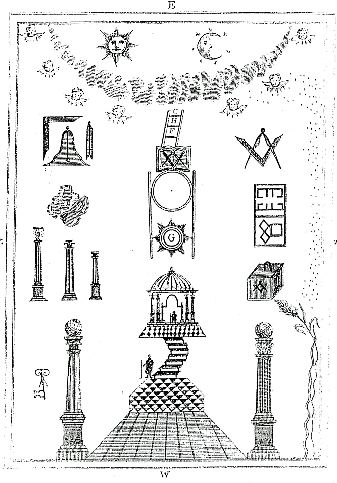 |
Illustration 1
|
Illustration 2
|
 |
 |
Illustration 3
|
Illustration 4
|
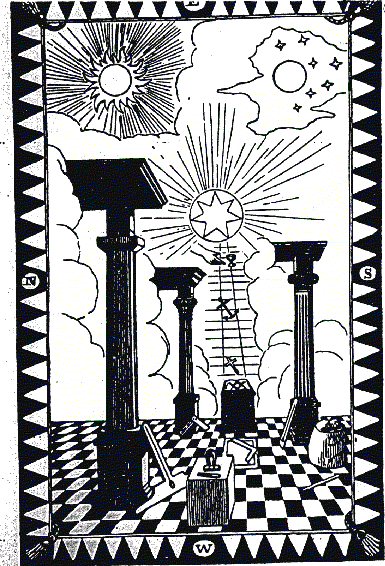 |
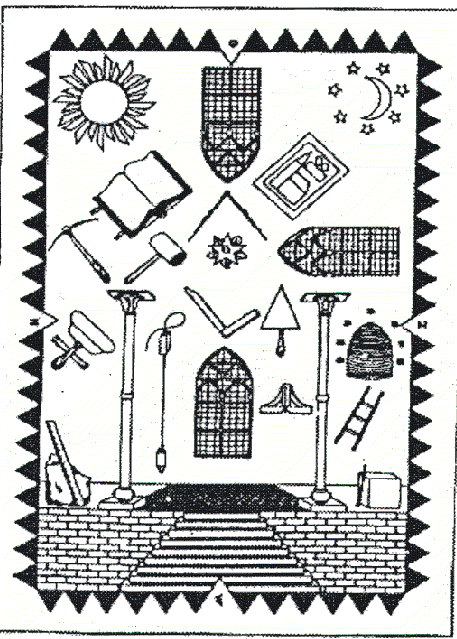 |
Illustration 5
|
Illustration 6
|
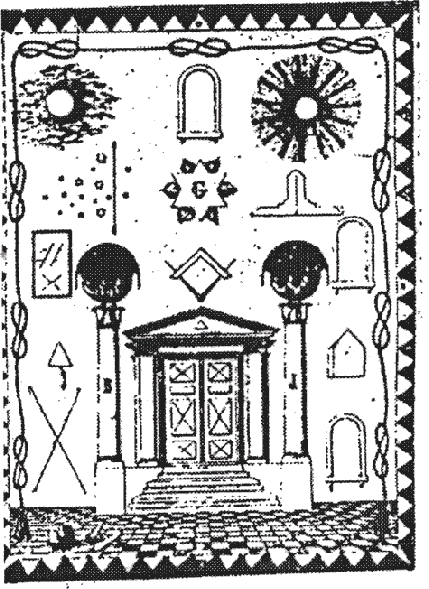 |
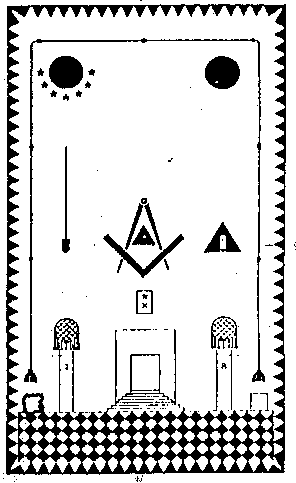 |
Illustration 7
|
Illustration 8
|
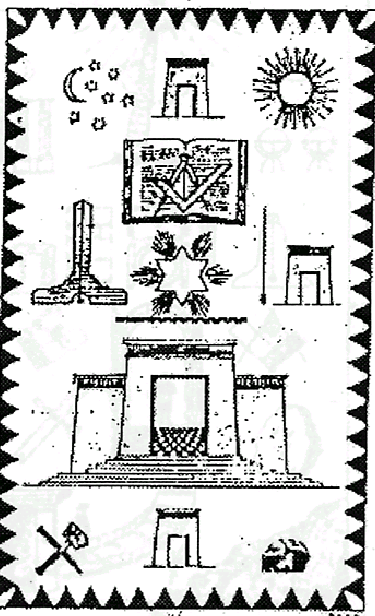 |
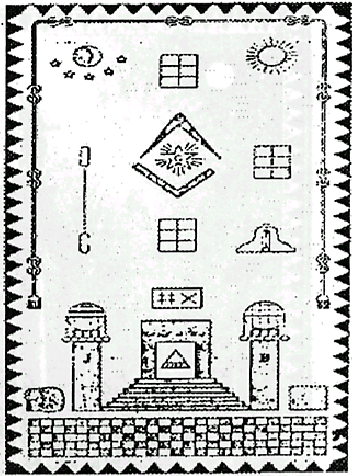 |
Illustration 9
|
Illustration 10
|
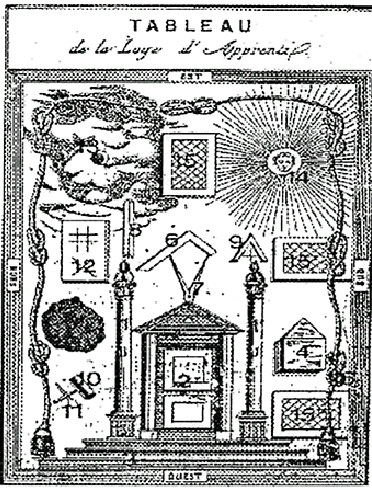 |
 |
Illustration 11
|
Illustration 12
|
 |
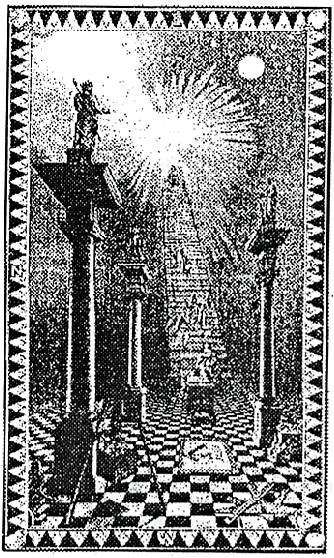 |
Illustration 13
|
Illustration 14
|
Notes
1) Phi:
Proportion is the relationship of the size of two things.
Phi possesses both qualities.
If you study the Fibonacci series and the Golden Rectangle
carefully, you will eventually realize that phi + 1 = phi * phi.
Consider: suppose that you start with a Golden rectangle having
a short side one unit long. Since the long side of a Golden rectangle equals the
short side multiplied by phi, the long side of our rectangle is one times phi -
or simply phi.
Now suppose that you swing the long side to make a new Golden
rectangle. The short side of the new rectangle is, of course, phi units long,
and the long side is that times phi, or phi * phi. This describes a Geometric
proportion.
But we also know from simple geometry that the new long side
equals the sum of the two sides of the original rectangle, or phi + 1. This
describes an Arithmetic proportion.
Since these two expressions describe the same thing, they are
equivalent, and so
phi + 1 = phi * phi
The resulting proportion is both arithmetic and geometric. It
is thus perfect proportion; you could think of it as the place on some imaginary
graph where the curved line of multiplication crosses the straight line of
addition.
2) Sun ’s light:
Here is a model of how the sun would shed its light if a
building, with equal walls, were placed in the Northern
hemisphere.

3) Other examples of Divine Proportion in nature
Pine cones:
Pine cones show the Fibonacci Spirals clearly. Here is a
picture of a pinecone seen from its base (sorry the quality is a bit poor) and
another with the spirals emphasized: red in one direction and green in the
other.
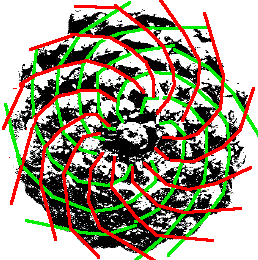
Some common trees with their Fibonacci leaf arrangement numbers
are:
Leaf arrangements of common trees:
-
1/2 elm, linden, lime, grasses
-
1/3 beech, hazel, grasses, blackberry
-
2/5 oak, cheery, apple, holly, plum, common groundsel
-
3/8 poplar, rose, pear, willow
-
5/13 pussy willow, almond
One estimate is that 90 percent of all plants exhibit this
pattern of leaves involving the Fibonacci numbers.
Seeds:

Fibonacci numbers can also be seen in the arrangement of seeds
on flowerheads. Here is a diagram of what a large sunflower or daisy might look
if magnified. The centre is marked with a black dot.
You can see that the seeds seem to form spirals curving both to
the left and to the right. If you count those spiraling to the right at the edge
of the picture, there are 34. How many are spiraling the other way? You will see
that these two numbers are neighbors in the Fibonacci series.
Human hands:
Look at your own hand:

If you measure the lengths of the bones in your finger (best
seen by slightly bending the finger) does it look as if the ratio of the longest
bone in a finger to the middle bone is Phi? What about the ratio of the middle
bone to the shortest bone (at the end of the finger) - Phi again?
Bibliography
** Oosterveen, A.C., “Het Tableau” (presented to Orde & Vlijt Lodge #32, Gorinchem, The Netherlands,
November 1997)
** MacNulty, W.K., “Freemasonry - A journey through ritual and
symbol”
** Lawlor, R., “Sacred Geometry - Philosophy and Practice”
** Conseil, D., “A Journey to the Center of the Letter G - A Pythagorician
Meditation” (presented to
Sinim Lodge, Tokyo, Japan, 1997)
** Knott, R., “Fibonacchi Numbers and the Golden Section”
back to top |
![]()























